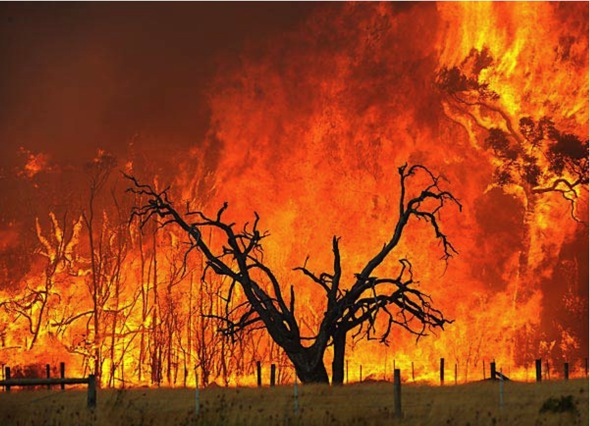Here we are talking about bushfires, any fire in natural vegetation that is not undertaken for some management purpose. Due to the large size of the State, extending from the tropics down to cool temperate areas in the south, bushfires can occur in Western Australia at almost any time of the year. The main focus of our website is the southwestern quarter but bushfires are an issue over the whole of the State.
The BFF advocates better management of fire in WA, especially on forested lands, to reduce the impact and severity of bushfire damage.
This sort of conflagration is what we are trying to avoid!

![]()
This was Victoria in February 2009, a fire disaster which resulted in the loss of over 170 lives, but the same thing could so easily happen here in several parts of the South West of the State.
The standard of fire management in WA has declined to a dangerous level. Unless urgent action is taken to improve it, WA is headed for a major fire disaster, and one much worse than the 2010 Toodyay fire that destroyed 38 homes.
We came perilously close to a Canberra-style disaster in the Perth Hills in 2005. We learned nothing from that event, so we had the 2011 Roleystone disaster, and then, soon after, the Margaret River fire. In 2014 another damaging bushfire occurred at Stoneville. In 2015, we saw major bushfires in forest country at Boddington and Northcliffe. The latter caused huge damage to beautiful regrowth karri forest. The total area of those fires was almost as great as the area burnt in the 1961 fire disaster, as this graph shows.
And this is just for the Southwest forest area. A similar pattern exists for the rest of the State, but those data are not available to us.
It is clear from the increasing area and severity of bushfires over the last 10 years or so, that the State’s current approach to fire management is failing and needs major restructuring. While some recent advances have been made in fire management on crown lands in the Southwest, we continue to see large and damaging bushfires on private land, in the agricultural zone and in the Kimberley region.
In this website we draw attention to the problems and propose changes to address the real needs of rural fire management. While we can improve the situation with better planning, better coordination between agencies and more on-ground resources, all it needs in WA is the right combination of severe fire weather and the high fuel loads now common in the South West and we could have a disaster of Victorian magnitude on our hands. We can’t control the weather but we can control the fuel loads – but it is not happening to the extent necessary.
The Ferguson Report into the 2016 Yarloop fire disaster was released by the State Government in late June 2016 Euan Ferguson is to be commended for an excellent report that, if implemented, will greatly improve the standard of fire management in WA.
Western Australia stands at a crossroads. We have a bushfire management system that has demonstrably failed. The State Government has had a comprehensive review by an expert in the field who has recommended major changes. It has accepted the main recommendations in the Ferguson report but now needs to follow through and implement the changes.
Note: We use acronyms such as CALM (Department of Conservation and Land Management), DEC (Department of Environment and Conservation), and FESA (Fire and Emergency Services Agency). Some text refers to CALM instead of DEC as the matter being discussed occurred when the agency had that title. The same comments apply to FESA, which changed to the Department of Fire and Emergency Services (DFES) in 2012. DEC became the Department of Parks and Wildlife (DPaW or PAW). In 2017 PAW became the Department of Biodiversity Conservation and Attractions (DBCA). Basically, CALM, DEC, PAW and DBCA are the same agency.
